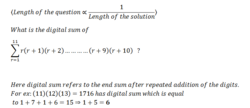This section requires Javascript.
You are seeing this because something didn't load right. We suggest you, (a) try
refreshing the page, (b) enabling javascript if it is disabled on your browser and,
finally, (c)
loading the
non-javascript version of this page
. We're sorry about the hassle.
4 solutions
Now that's brilliant!
Well, overrated! (It is level 5 now)
∑ r = 1 1 1 r ( r + 1 ) ( r + 2 ) . . . . ( r + 9 ) ( r + 1 0 )
T r = ( r − 1 ) ! ( r + 1 0 ) !
T r = 1 1 ! ( r + 1 0 1 1 )
1 1 ! ∑ r = 1 1 1 ( r + 1 0 1 1 )
Now using the formula ( r r ) + ( r + 1 r ) + ( r + 2 r ) + . . . . + ( n r ) = ( n + 1 r + 1 ) ,
∑ r = 1 1 1 ( r + 1 0 1 1 ) = ( 2 2 1 2 )
Now the sum becomes -
∑ r = 1 1 1 r ( r + 1 ) ( r + 2 ) . . . . ( r + 9 ) ( r + 1 0 ) = 1 1 ! ( 2 2 1 2 )
Now finding the above(which is easy) and then finding digital sum, Io, you get the answer as 9
Not a mathematical approach,
each term contains multiple of 9 , thus sum should be divisible by 9
Let the summation be written as S = ∑ r = 1 1 1 T r
where T r = ∏ j = 0 1 1 ( r + j )
T r is a product of 11 consecutive integers. One of those integers would be divisible by 9. Hence, T r would be divisible by 9.
Since, S is a summation of terms, each of which is a multiple of 9, S is also divisible by 9.
Applying the rules of divisibility by 9, the digit sum should come out to be 9.
I posted it as a comment
Log in to reply
i had already put up this approach before your post.


Note that digital sum of an integer N > 0 is
However, note that the one of the 11 consecutive integers r , r + 1 , . . . , r + 1 0 must always be a multiple of 9, hence their product is a multiple of 9. Thus the sum in the question is a multiple of 9 i.e. the answer is 9. (It is not necessary to calculate the actual value of the sum).